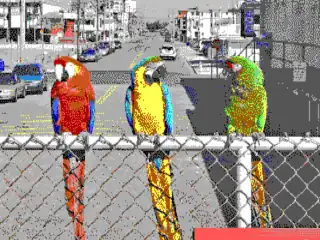Plantronics Colorplus
The Plantronics Colorplus is a graphics card for IBM PC computers, first sold in 1982. It is a superset of the then-current CGA standard, using the same monitor standard (4-bit digital TTL RGBI monitor) and providing the same pixel resolutions.[1] It was produced by Frederick Electronics (of Frederick, Maryland), a subsidiary of Plantronics since 1968, and sold by Plantronics' Enhanced Graphics Products division.[2][3]
 | |
| Release date | 1982 |
|---|---|
| Manufactured by | Plantronics Enhanced Graphics Products |
| Designed by | Frederick Electronics |
| Architecture | Motorola MC6845 |
| Cards | |
| Entry-level | Plantronics Colorplus |
| High-end | ATI Graphics Solution, Paradise AutoSwitch EGA 480 |
| History | |
| Predecessor | CGA |
| Successor | EGA |
The Colorplus has twice the memory of a standard CGA board (32k, compared to 16k). The additional memory can be used in graphics modes to double the color depth, giving two additional graphics modes—16 colors at 320 × 200 resolution, or 4 colors at 640 × 200 resolution.[4]
It uses the same Motorola MC6845 display controller as the previous MDA and CGA adapters.[1]
The original card also includes a parallel printer port.
Output capabilities


CGA compatible modes:
- 160 × 100 16 color mode (actual a text mode using
▌,▐and█) - 320 × 200 in 4 colors from a 16 color hardware palette. Pixel aspect ratio of 1:1.2.
- 640 × 200 in 2 colors. Pixel aspect ratio of 1:2.4
- 40 × 25 with 8 × 8 pixel font text mode (effective resolution of 320 × 200)
- 80 × 25 with 8 × 8 pixel font text mode (effective resolution of 640 × 200)
In addition to the CGA modes, it offers:[4]
- 320 × 200 with 16 colors
- 640 × 200 with 4 colors
- "New high-resolution" text font, selectable by hardware jumper
The "new" font was actually the unused "thin" font already present in the IBM CGA ROMs, with 1-pixel wide vertical strokes. This offered greater clarity on RGB monitors, versus the default "thick" / 2-pixel font more suitable for output to composite monitors and over RF to televisions but, contrary to Plantronics' advertising claims, was drawn at the same 8 × 8 pixel resolution.
Software support
Few software made use of the enhanced Plantronics modes, for which there was no BIOS support.
A 1984 advertisement[2] listed the following software as compatible:
- Color-It
- UCSD P-system
- Peachtree Graphics Language
- Business Graphics System[5]
- Graph Power
- The Draftsman
- Videogram
- Stock View
- GSX
- CompuShow (320 × 200 mode)[6]
Some contemporary software has added support for Plantronics modes:
- Planet X3, released by American YouTuber David "The 8-Bit Guy" Murray in 2019, was the first video game known to have Colorplus support (320 × 200 with 16 colors). This support was added by Planet X3 enthusiast Benedikt Freisen.[7]
- Attack of the Petscii Robots by American YouTuber David "The 8-Bit Guy" in 2020, ported to MS-DOS computers with a graphics mode providing support for Plantronics Plus.
- Benedikt Freisen produced updated drivers in 2021 that add Colorplus support to Sierra's adventure games that ran on Sierra's Creative Interpreter.[8]
- FastDoom, a port of Doom (1993 video game) developed by Victor Nieto, added support for ColorPlus 320 × 200 with 16 colors mode in 2021.[9]
Hardware clones
Some third-party CGA and EGA clones, such as the ATI Graphics Solution and the Paradise AutoSwitch EGA 480,[10] could emulate the extra modes (usually describing them simply as 'Plantronics mode').
The Thomson TO16 (a PC-XT compatible)[11] and the Olivetti M19 supported Plantronics modes,[12] along with CGA.
See also
- Tandy Graphics Adapter, a graphics hardware system with similar capabilities.
- Quadram Quadcolor
- Orchid Graphics Adapter
- Hercules Graphics Card
- Olivetti M19
- Thomson TO16
References
- Machrone, Bill (July 1983). "Three Alternative Graphics Boards". PC Magazine. pp. 435–438.
- Colorplus High Resolution Color Graphics Adapter from Plantronics. Frederick Electronics. 1984.
- Staff writer (July 1, 1975). "Modern industries heart of area economy". The News. Frederick, Maryland: 4, 8 – via Newspapers.com.
- Elliott, John (March 28, 2015). "Plantronics ColorPlus Notes". John Elliott's homepage. Retrieved 2023-04-17.
- "Business Graphics System". PC Magazine. Vol. 4, no. 12. June 11, 1985. p. 203.
- Berry, Bob (1993). "CompuShow v8.60 Documentation". cd.textfiles.com. Canyon State Systems.
- Murray, David (19 February 2019). "Planet X3 is Here! And with new video modes!". The 8-Bit Guy. Retrieved 6 September 2019.
- Freisen, Benedikt (2022-12-13), FOSS SCI Drivers, retrieved 2023-01-24
- Nieto, Victor (Aug 16, 2021). "FastDoom 0.8.7 release notes". FastDoom at GitHub.com. Retrieved 18 November 2022.
- Hart, Glenn (December 22, 1987). "EGA Plus Cards: VGA res for EGA monitors". PC Magazine. p. 218.
- "Ordinateur : Le Thomson TO16 XP HD". Association MO5.COM (in French). 2007.
- Caratteristiche techniche Personal Computer M19 (PDF) (in Italian). Olivetti. March 1986.
External links
- "+COLORPLUS Shatters The Mold.", an original advertisement.
- A USENET posting describing the Plantronics Colorplus
- The technical documentation for the Paradise EGA chipset in the Amstrad PC-1640 describes its Plantronics compatibility mode.